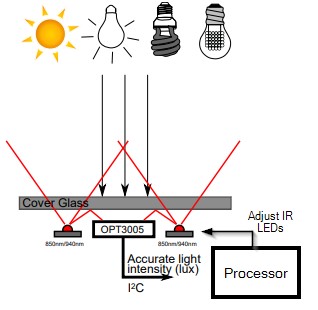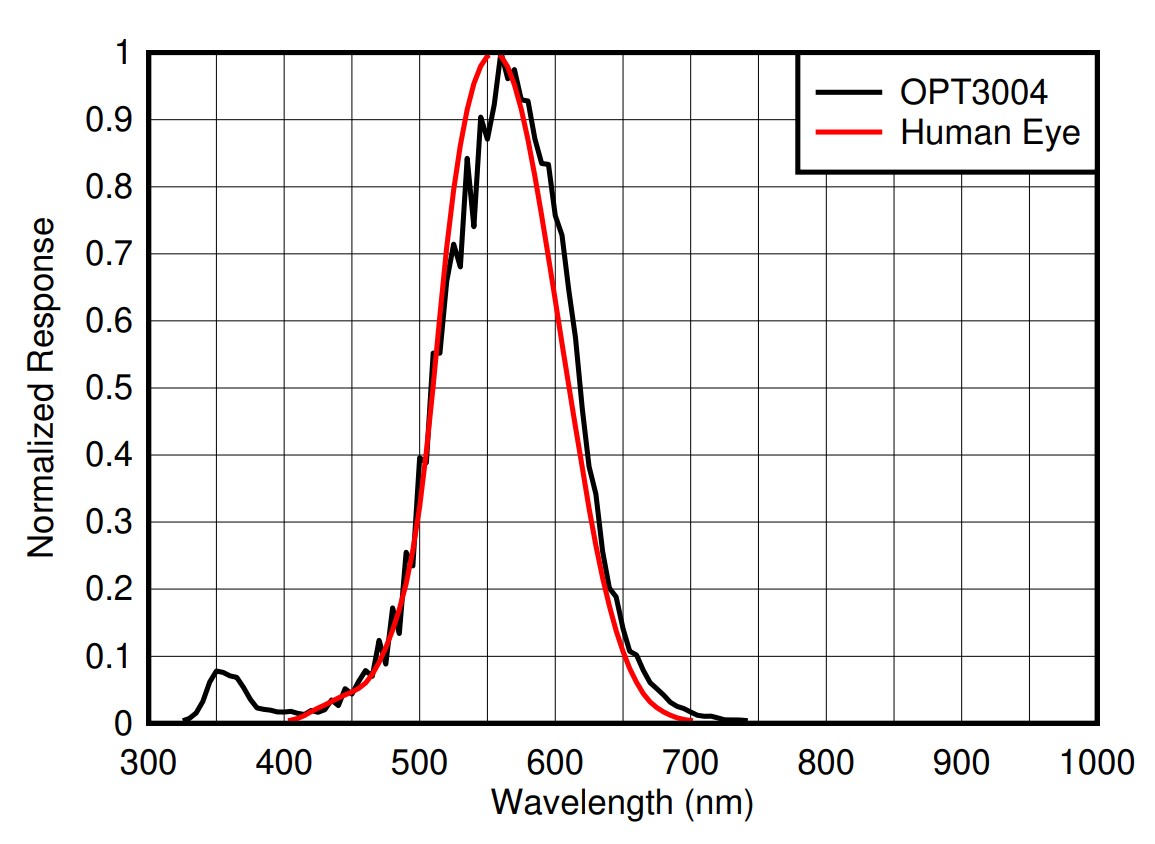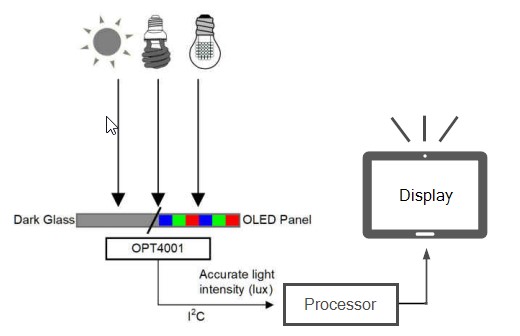SBEA006C April 2018 – January 2024 OPT3001 , OPT3001-Q1 , OPT3002 , OPT3004 , OPT3005 , OPT3006 , OPT3007 , OPT4001 , OPT4001-Q1 , OPT4048 , OPT4060
Light sensors, also known as photodetectors, detect the presence or absence of light, and the intensity of the light. These sensors convert light energy into an electrical signal, which can then be analyzed or used to trigger an action. Light sensors are used in a wide range of applications, from controlling the brightness of display screens and adjusting the aperture of cameras to alerting security systems of a possible intrusion. This article discusses the features required to pick a light sensor in common use cases, such as tamper detection, day and night detection, LED brightness adjustment, display brightness adjustment, and color adjustment.
Tamper Detection
Light sensors in tamper detection applications detect a lux (brightness) change across a threshold in the ambient light levels, indicating that a device or system has been tampered with. The light sensor is typically placed inside or around a mechanical system and programmed to trigger an alarm or alert when the ambient light levels change significantly, such as when someone opens, blocks, or tampers with the system. This process is commonly used in security systems, such as alarm systems, access control systems, ATMs, and smart meters, as shown in Figure 1-1, to detect physical attacks or attempts to bypass security measures. Tamper detection using a light sensor can be a reliable and cost-effective way to enhance the security of devices and systems and combines with other security measures and sensors to provide comprehensive security.
Power and a broad light spectrum range are significant factors for tamper detection. A broad-spectrum sensor detects any type of light change in the UV, visible, and IR spectrums. A broad spectrum is an advantage for tamper detection since any light change, regardless of the type of light or source, can indicate tampering. Many tamper detection devices are battery-powered and require low power consumption to provide long battery life. The OPT3002 has a wide spectral range from 300nm to 1000nm and low current, making the device an excellent choice for low-power tamper detection.
 Figure 1 Smart Meter With Light Sensor
Block Diagram
Figure 1 Smart Meter With Light Sensor
Block DiagramDay and Night Detection
A light sensor can distinguish between day or night by measuring the amount of ambient light. During the day, the light outdoors is bright and intense. Light outdoors changes brightness throughout the day from bright daylight to dark nighttime. By monitoring the changes in light intensity, a light sensor accurately indicates whether it is day or night. Day and night detection is in various applications, such as outdoor lighting, driver monitoring cameras, and security systems.
The spectral response of the light sensor must tightly match the photopic response of the human eye and include significant infrared rejection. By rejecting other types of light outside the human eye spectrum, the light sensor can sense the brightness of light comparable to how a human senses the light. The OPT3004 and OPT4001 closely match the human eye spectrum and reject > 99% of IR. For applications that introduce IR into the environment, such as Video doorbells, IP network cameras, and video surveillance, a strong IR rejection is necessary for accurate sensing. As shown in Figure 1-2, the OPT3005 light sensor rejects IR from the environment and the IR that reflects back from the coverglass. The OPT3005 rejects 99.99+ percent (4+ orders) of Near Infrared (NIR) light over a large angle of incidence, making this device an excellent choice for video surveillance applications.
Typically, a set light intensity threshold determines if it is day or night when the light intensity crosses the threshold. TI light sensors have interrupt pins for setting threshold triggers without host or processor intervention, thus saving power.
 Figure 2 OPT3005 in Video Surveillance
Application
Figure 2 OPT3005 in Video Surveillance
ApplicationLED Brightness Adjustment
Light sensors can measure the ambient light level in the environment and adjust the output of the LED accordingly. This process is commonly used in lighting systems to optimize the brightness of the LED based on the surrounding lighting conditions. This feature not only improves the visual comfort and energy efficiency of the lighting system but also extends the lifespan of the LED by reducing the operating temperature. Light sensors for LED brightness adjustment are in home appliances, smart homes, electronic peripherals, and automotive interior lighting, where ambient lighting conditions vary significantly throughout the day.
Spectral accuracy and power consumption are important sensor characteristics for LED brightness adjustment. Spectral accuracy depends on matching closely with the visible spectrum, the spectrum of light the human eye can see, shown in Figure 1-3. UV and IR light leakage gives the light sensor a brighter measurement causing the system to think it is brighter than it actually is. By rejecting other types of light outside the human eye spectrum, the light sensor can sense the brightness of light comparable to how a human perceives light. Many low-power applications, such as hand-held tools and appliances, need low-power sensors to extend battery life.
The OPT3004 tightly matches the visible light spectrum and rejects > 99% of IR over ±85° angle of incidence. With an operating current of 1.8μA and a sleep current of 300nA, OPT3004 is an excellent fit for battery-powered applications.
 Figure 3 OPT3004 and Human Eye Spectrum
Curves
Figure 3 OPT3004 and Human Eye Spectrum
CurvesDisplay Brightness Adjustment
Display brightness adjustment is a popular application of light sensors, especially in personal electronic devices such as smartwatches, tablets, and laptops. These sensors are also in automotive and industrial applications such as infotainment and human-machine interfaces. Figure 1-4 shows an example of a light sensor in a display system. Light sensors measure the ambient light level and adjust the display brightness accordingly, providing a comfortable viewing experience and saving battery life. Typically, the brightness adjustment matches the brightness of the environment. When the ambient light is high, the display brightness increases to improve visibility. When the ambient light is low, the display brightness is decreased to avoid discomfort and lowers system power extending the display panel lifetime.
Size, speed, and resolution are essential considerations for display applications. Small package size is best for thin bezels and small displays, such as smartwatches. A fast sensor enables quick adjustments to accommodate a sudden change in lighting conditions for a seamless user experience. High resolution is essential for finer control of display brightness and can hide the light sensor with more discretion behind dark cover material, such as in a bezel. For a more in-depth read on speed and resolution, see The Value of a High-Speed, High-Resolution Light Sensor application brief. TI's OPT4001 is a great choice for this application due to the impressive speed and resolution and also comes in an ultra-small package for thin bezels.
TI offers automotive-grade OPT3001-Q1 and OPT4001-Q1 ambient light sensors for automotive applications and end equipment influenced by high temperatures.
 Figure 4 Display Brightness Diagram
Using OPT4001
Figure 4 Display Brightness Diagram
Using OPT4001Color Adjustment
Light sensors for color adjustment measure the color temperature and adjust the colors of a display accordingly. This process is commonly used in TVs, monitors, laptops, smartphones, and tablets, to optimize the display colors based on the surrounding lighting conditions. The color temperature of the display is adjusted to a warmer or cooler temperature, as shown in Figure 1-5, to make the colors appear more natural and accurate. A display can also use color sensors to adjust color saturation and contrast to enhance the visual quality and reduce eye strain.
 Figure 5 Example of Warm, Neutral
(Sheet of Paper), Cool CCT
Figure 5 Example of Warm, Neutral
(Sheet of Paper), Cool CCTResolution, speed, and color space are the most significant considerations for color adjustment. High resolution makes sure the sensor can measure light intensity in low light conditions or behind cover material and make subtle brightness adjustments. Speed allows for a smooth transition between color-changing lighting conditions. Color space affects the color sensed and the performance of the measurement of the sensor. The two commonly used color models are the RGB color space and XYZ color space. See the RGB and XYZ Color Space Comparison application brief for an in-depth color sensor comparison.
TI offers both high-resolution and high-speed XYZ light sensors (OPT4048) and RGB light sensors (OPT4060). TI color light sensors improve the color accuracy and visual quality of a display or lighting system in various lighting conditions.
Conclusion
Light sensor applications vary from simple light intensity thresholds to active color-adjusting displays. Light sensors improve user experience, optimize energy consumption, and extend device lifetime. While the importance of the features of a light sensor depends on the application, the fundamental design considerations are the spectral response, speed, resolution, power, size, and measurement range. Texas Instruments offers a diverse light sensor portfolio that includes the best part for most applications. As technology advances and new use cases emerge, the demand for light sensors increases, driving innovation and making technology that can detect the world around it.
For more information and training on TI light sensors see TI's Precision Labs Training Videos: Light Sensors.
Table 1 presents a summary of the TI light sensor portfolio.
| Tamper Detection | Day and Night Detection | LED Brightness Adjustment | Display Brightness Adjustment | Color Adjustment |
|---|---|---|---|---|
| OPT3002 | OPT3004 OPT3005 |
OPT3004 OPT3001-Q1 |
OPT4001 OPT3007 OPT3004 OPT3001-Q1 OPT4001-Q1 |
OPT4048 OPT4060 |